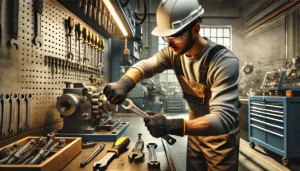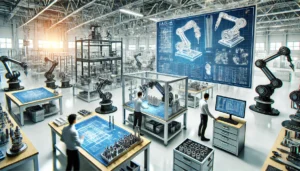Choosing the material for machined parts impacts the component’s performance, longevity, and cost. Understanding the application’s requirements and balancing durability against cost constraints is key. The ideal material is the one that meets a part’s design use and keeps the manufacturing budget reasonable.
Key Considerations in Material Selection
- Mechanical Properties
The chosen material should meet the part’s mechanical criteria such as strength, fatigue resistance, and hardness. Components that experience high loads or wear require stronger materials that will not fail under extreme stress. In these scenarios, steel or titanium are often selected due to their rigidity and resistance to deformation. Lastly, depending on the application, the material needs to be at the right level of flexibility or rigidity.
- Environmental Resistance
The environmental conditions where a material will be used is another significant consideration when selecting the appropriate material for its particular application. This includes resistance to corrosion, oxidation, temperature extremes, chemical exposure, or moisture. For instance, stainless steel is common in the food processing and marine industries because it can withstand corrosion. The selection of material must ensure that the part will still be useful and reliable over time under very tough conditions.
- Machinability
A crucial element that affects the choice of materials for various components is the ability of that material to be easily machined. A material that has high machinability is easier to shape and finish, which means less time and effort is consumed, thus lowering manufacturing expenses. Take Aluminum as an example, it is easy to machine and, that is why it is used in many industries like automobile and aviation. However, titanium and high strength steels are some examples of materials that are difficult to machine. During the manufacturing of such materials, additional time, specific tools, and a qualified workforce are needed, which all adds to the overall expense and duration needed to complete the job.
- Cost Considerations
The rates of raw materials and their availability affects pricing. Aluminums, plastics, and mild steel are super affordable while materials like titanium and specialty alloys come with exorbitant price tags and low availability. Performance grade materials will help with a part’s function but they also lead to excessive production costs and do not add any value in the long run. When partaking in a project, the material cost always needs to be evaluated in the case of overengineering.
- Availability
Material availability can impact the production timeline and cost. Materials that are commonly available and in high demand are typically easier to source and may offer more competitive pricing. However, some specialized materials may have longer lead times, especially if they are imported or custom-produced. Depending on the urgency of the project, material availability can influence the overall timeline of production and delivery.
Common Materials Used in Machining
- Aluminum Alloys
Aluminum alloys have an advanced ratio of strength to weight which makes them easy to ship. These alloys have the highest demand in engineering sectors like marine, automotive, space, and electronics. Aside from these industries, aluminum alloys can be used to make parts which require anti-corrosive materials. Its being non corroding makes it suitable for a broad range of uses. Aluminum alloys are preferred when strength is needed but excess weight should be avoided, like in the case of aircraft or lightweight automobile parts.
- Stainless Steel
Stainless steel is esteemed for its high numerator of strength and non-corrosiveness as well as the value it offers. It is ideal for places where harsh conditions are present such as marine gears and medical handicraft as well as food industry tools. Its high price rate and difficulty in working with it makes it less appealing for most. It triumphs aluminum alloys in performance however guaranteeing that cost is not an issue helps in aiding this downside.
- Titanium Alloys
Titanium surfaces are often used in performance demanding locations such as the aerospace and medical sector because of its supreme strength, non-corrosive feature, and lightweight. When titanium is alloyed, while it is expensive, and not easy to manufacture, its increased benefits make up for it. Due to their price and difficulty, they are only utilized when absolutely needed where performance arguments do not recompense other options.
- Plastics
ABS, PTFE, and PEEK are often utilized for lightweight corrosion resistant components, as these other kinds of plastic are comparably simple to work with. They also possess good resistance to chemicals as well. Plastics are extensively applied in the electronics, automotive and medical parts industries where strength to weight ratio is critical. They are helpful in applications where the use of metal is impractical due to its price or weight as well.
Balancing Durability and Cost
Striking the balance between durability and cost is a nuanced one to achieve. While excellent materials such as titanium and certain high-performance alloys have unmatched qualities, the expense associated with them can be unjustifiable. For instance, as long as sufficient strength and durability is provided for the task, an aluminum part can easily take the place of a titanium one where cost is an important factor.
However, if the material being used is too soft, the part may wear off easily, requiring it to be replaced. Take high-stress situations: using low-cost materials like plastic or low-carbon steel would not only result in problems, but also a high level of operational headaches.
Some businesses will prefer a costlier material if the design is either thinner or less intricate than before. Additionally, some manufacturers try to cut costs by picking materials that offer reasonable value, without trying to over-engineer the part. For example, selecting a machinable alloy that has reasonable strength can help lower costs of manufacturing while the part is still useful.
Conclusion
One of the most important and last steps in the manufacturing process is choosing an appropriate Material for a machined component. It will affect the performance, cost, and the durability of the part. Every material selected should satisfy the functional needs of the part while ensuring its cost effectiveness. By the combination of determination of mechanical properties, environmental resistance, ease of machining the material, and the cost of the material, the manufacturers can minimize the expense while maximizing the value of the product. The harder part will always be understanding the needs of the application and materials so the right material will give the right value for the job. Doing so properly means that fabrication of cost effective, highly reliable components that satisfy customer needs can be done without excessive waste or effort.










